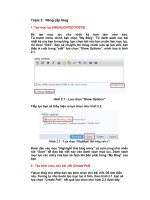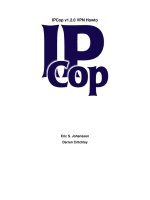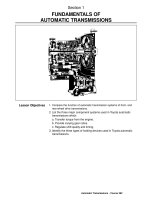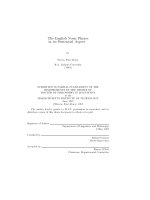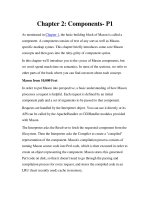Week 2 - Noun Phrase (p1) pptx
Bạn đang xem bản rút gọn của tài liệu. Xem và tải ngay bản đầy đủ của tài liệu tại đây (1.08 MB, 73 trang )
E_English Grammar Course
E_English Grammar Course
Unit 2
NOUN PHRASE
1. Noun and noun classes
2. Reference and the articles
3. Grammatical categories of nouns
4. Pronouns
Issues
Issues
1. Noun and noun classes
2. Reference and the articles
3. Grammatical categories of nouns
4. Pronouns
Issues
Issues
Noun – Noun classes
1.1
Noun
Noun
= a word used TO NAME …
•
A person
(E.g.: Tom, John, Bill Jones)
•
A thing
(E.g.: bed, chair, table, house)
•
An animal
(E.g.: cat, dog, tiger, lion)
•
An abstract concept
(E.g.: peace, war, independence)
1/1
Noun – Noun classes
1.2
1/2
Noun classes
Noun classes
Proper nouns
Proper nouns
Common nouns
Common nouns
See more in 4.2 - 4.4
Noun – Noun classes
1.2
1/3
Noun classes
Noun classes
Proper nouns
Proper nouns
Bill Clinton
the Nile
the UNICEF
geographical names
personal names
names of institutions/
organizations
calendar items
Easter
Noun – Noun classes
1.2
1/4
car
cars
Noun classes
Noun classes
Common nouns
Common nouns
Count Ns
Count Ns
Non-count Ns
Non-count Ns
Singular
Plural
Singular
salt
Noun – Noun classes
1.2
1/5
Common nouns
Common nouns
Count Ns
Count Ns
Non-count Ns
Non-count Ns
Concrete Abstract
chair
gold
activit
y
beauty
Noun – Noun classes
Noun classes
Noun classes
Proper nouns
Proper nouns
Common nouns
Common nouns
Count Ns
Count Ns
Non-count Ns
Non-count Ns
E.g. Tom, John
Concrete
Concrete
Abstract
Abstract
1.2
cat failure rice peace
1/6
Noun – Noun classes
Let’s check
–
To which classes does each of the following
nouns belong to?
•
furniture
•
garden
•
victory
•
serenity
•
Friday
1.2
1/7
Noun – Noun classes
Let’s check
•
Furniture: Non-count, concrete
•
Garden: Count, concrete
•
Serenity: Non-count, abstract
•
Friday: Proper (calendar item)
•
Victory: Count, abstract
1.2
1/8
1. Noun and noun classes
2. Reference and the articles
3. Grammatical categories of nouns
4. Pronouns
Issues
Issues
Reference – The articles
2.1
2/1
Reference
Reference
Generic
Generic
Specific
Specific
Unique
Unique
See more in 4.16 - 4.30
Reference – The articles
2.1
2/2
E.g.: - John loves Mary.
Reference
Reference
Unique
Unique
proper noun
Reference – The articles
2.1
2/3
Reference
Reference
Generic
Generic
Specific
Specific
vs.
C/f.
(1) A lion and two tigers are sleeping in the cage.
(2) Tigers are dangerous animals.
Reference – The articles
2.1
2/4
Specific or generic?
(1) A lion and two tigers are sleeping in the cage.
(1) = SPECIFIC (referring to particular specimens of
the class ‘tiger’.
(2) Tigers are dangerous animals.
(2) = GENERIC (referring to the class ‘tiger’ without
specific reference to particular tigers)
Reference – The articles
2.1
Generic Reference & the Articles
Generic Reference & the Articles
2/5
1. A German is a good musician.
2. Germans are good musicians.
3. The Germans are good musicians.
4. The German is a good musician (not common).
Reference – The articles
2.1
Specific Reference & the Articles
Specific Reference & the Articles
2/6
COUNT NONCOUNT COUNT NONCOUNT
SINGULAR the tiger the furniture a tiger (some)
furniture
PLURAL the tigers (some)
tigers
DEFINITE INDEFINITE
Reference – The articles
2.2
2/7
The articles
The articles
Definite
Definite
Indefinite
Indefinite
Zero (Ø)
Zero (Ø)
E.g.: - The earth goes around the sun. (definite)
- He bought a new bike yesterday. (indefinite)
- He has just arrived in Ø London. (zero)
Reference – The articles
2.2
Definite article ‘the”
Definite article ‘the”
Immediate situation
Larger situation
Anaphoric reference
Cataphoric reference
Sporadic reference
Logical use of THE
With body parts
2/8
Reference – The articles
2.2
Definite article ‘the’
Definite article ‘the’
2/9
Anaphoric reference
Cataphoric reference Sporadic reference
= the uniqueness of
reference of some phrase
(the X) is supplied by
information given earlier
in the discourse
The modification of the
noun phrase restricts the
reference of the noun
E.g. The wine that France
produces
Reference is made to an
institution which may be
observed recurrently at
various places and times.
E.g. the theatre, the
cinema, the press, etc.
Reference – The articles
2.2
2/10
Definite article ‘the’
Definite article ‘the’
Anaphoric reference
Direct
= The same head noun has occurred in the text and a relation of co-
reference exists between two NPs
E.g.: Susan bought a TV and a video recorder, but she returned the
video recorder because it was defective.
Reference – The articles
2.2
2/11
Definite article ‘the’
Definite article ‘the’
Anaphoric reference
Indirect
= A reference becomes part of the hearer’s knowledge indirectly
E.g.: John bought a new bicycle, but found that one of the wheels was
defective.
Reference – The articles
2.2
Definite article ‘the’
Definite article ‘the’
Immediate situation
= derived from the
extra-linguistic
situation.
E.g.: - The roses are beautiful. (said in the garden)
- Have you fed the dog? (said in the domestic context)
2/12
Reference – The articles
2.2
Definite article ‘the’
Definite article ‘the’
= general knowledge
which is shared or
worldwide
E.g.: the sun the Equator
the Republic the North Pole
the cosmos the Renaissance
Larger situation
2/13


